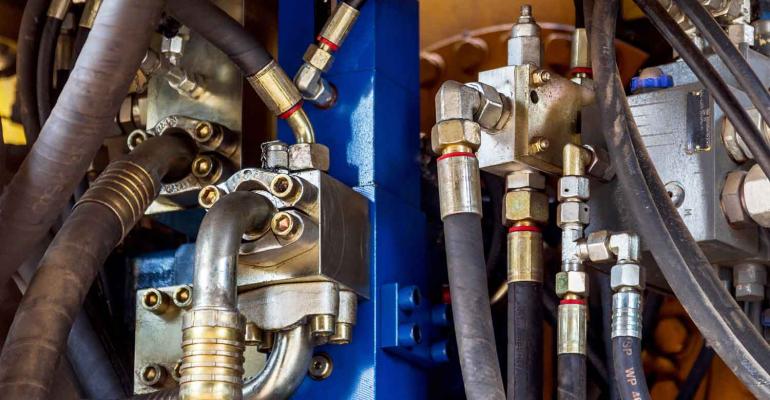In the intricate world of hydraulic systems, every component plays a crucial role in ensuring smooth and efficient operation. Among these, hydraulic hoses are vital for transporting fluid under pressure, but how does their length impact the system's overall pressure? This question is not just of academic interest but has practical implications for the design and performance of hydraulic systems. As a leading hydraulic hose manufacturer, Passion Hose brings you insights into the relationship between hose length and pressure. This blog aims to shed light on this topic, helping you understand how to optimize your hydraulic systems for peak performance. Join us as we unravel the dynamics of hydraulic hoses and pressure.

Basics of Hydraulic Hose and Pressure
Hydraulic hoses are the arteries of any hydraulic system, conveying fluids under high pressure to various components. These hoses must withstand the system's pressure to function effectively, ensuring fluid is delivered efficiently to where it's needed. Pressure within a hydraulic system is generated by pumps, which force the fluid through the system, creating the necessary force to power the machinery. The hoses, therefore, must be robust and flexible enough to handle this pressure without leaking or bursting. Understanding the relationship between the hoses and the pressure they carry is fundamental to maintaining a reliable and efficient hydraulic system.
The Relationship Between Hose Length and Pressure
The length of a hydraulic hose can indeed affect the pressure within the system, primarily due to a phenomenon known as pressure drop. Pressure drop refers to the reduction in pressure as the fluid travels through the hose. The longer the hose, the more significant the pressure drop will be. This is because the fluid loses energy due to friction as it rubs against the inner walls of the hose, especially in longer lengths. Additionally, other factors like hose diameter, fluid viscosity, and flow rate also play a part in determining the pressure drop. Understanding these factors is crucial for designing a hydraulic system that maintains adequate pressure throughout its operation.
Minimizing Pressure Drop in Long Hydraulic Hoses
While a certain amount of pressure drop is inevitable, especially in longer hoses, there are ways to minimize it to maintain system efficiency. Here are some strategies:
● Opt for Larger Diameter Hoses: A larger diameter reduces the fluid's velocity, thereby decreasing the friction and the resultant pressure drop.
● Ensure Smooth Hose Routing: Avoid sharp bends and turns in the hose routing, as these can cause turbulence and increase pressure drop. Smooth, gradual bends are preferable.
● Select the Right Hose Material: Some hose materials offer smoother internal surfaces, reducing friction and pressure drop. Consult with Passion Hose to select the best material for your application.
● Regular Maintenance: Ensure hoses are regularly inspected and maintained. A worn or damaged hose can contribute to increased pressure drop and system inefficiency.
Choosing the Right Hose for Your System
Selecting the right hydraulic hose is not just about length; it's about understanding the specific requirements of your system and matching them with the right hose characteristics. The diameter, material, and type of hose can all significantly impact the system's pressure and efficiency. A hose with a larger inner diameter might reduce pressure drop, but it also needs to fit with the rest of your system and be capable of handling the required pressure. Additionally, the hose material should be compatible with the type of fluid it will carry and the operating environment. Passion Hose offers a wide range of hydraulic hoses designed for various pressures, temperatures, and applications. Consulting with experts at Passion Hose can help you make an informed decision, ensuring you choose a hose that maintains optimal pressure and performance.
Custom Solutions and Expert Advice from Passion Hose
Every hydraulic system has its unique challenges and requirements. Sometimes, off-the-shelf hoses might not be the perfect fit for your specific needs. This is where Passion Hose's custom solutions come into play. We understand that one size does not fit all when it comes to hydraulic hoses. Our team of experts is ready to work with you to design and manufacture hoses that meet your exact specifications, considering factors like length, diameter, material, and fittings. With custom solutions from Passion Hose, you can ensure that your hydraulic system operates efficiently, with minimal pressure drop and maximum reliability.
Conclusion
The length of a hydraulic hose can indeed affect the pressure within a system, but with the right knowledge and tools, this challenge can be effectively managed. By understanding the factors that contribute to pressure drop and implementing strategies to minimize it, you can ensure your hydraulic system operates efficiently, even over longer distances. Remember, the key to a well-functioning hydraulic system is not just the components you choose, but also the expertise and support behind them.
Elevate Your Hydraulic Systems with Expert Solutions from Passion Hose
Are you looking to optimize your hydraulic system or need advice on the right hose for your needs? Visit Passion Hose today to explore our range of quality hydraulic hoses and benefit from our expert advice. Let's work together to ensure your system is efficient, reliable, and ready to meet the demands of your operation. Contact us now for personalized solutions and support!